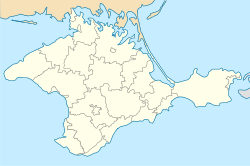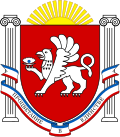Bilohirsk
Bilohirsk Къарасувбазар, Белогорск Belogorsk | |
|---|---|
| UA: Bilohirsk (uk); RU: Qarasuvbazar (crh), Belogorsk (ru), Bilohirsk (uk) | |
| Ukrainian transcription(s) | |
| • Ukrainian National | Bilohirsk |
| • ALA-LC | Bilohirsʹk |
| • ISO 9 | Bìlogìrsʹk |
| Russian transcription(s) | |
| • ISO 9 | Belogorsk |
| Etymology: white mountains (for Bilohirsk, Belogorsk) | |
| Coordinates: 45°3′16″N 34°36′8″E / 45.05444°N 34.60222°E | |
| Country | |
| Autonomous republic | Crimea (de jure) |
| Raion | Bilohirsk Raion (de jure) |
| Federal subject | Crimea (de facto) |
| Area | |
• Total | 5.42 km2 (2.09 sq mi) |
| Elevation | 180 m (590 ft) |
| Population (2014) | |
• Total | 16,354 |
| • Density | 3,398.52/km2 (8,802.1/sq mi) |
| Time zone | UTC+03:00 (MSK) |
| Postal code | 97600 — 97609 |
| Area code | +7-36559 |
| Website | http://belogorsk.crimea.ua/ |
 | |
Bilohirsk (until 1944 – Karasubazar, Ukrainian: Білогірськ; Russian: Белогорск, romanized: Belogorsk, Crimean Tatar: Qarasuvbazar/Къарасувбазар) is a city and the administrative centre of Bilohirsk Raion, one of the raions (districts) of the Autonomous Republic of Crimea, which is recognised by a majority of countries as part of Ukraine, but is occupied by Russia. Population: 16,354 (2014 Census).[1]
Geography
[edit]The city is located 25 miles east-northeast of Simferopol on the Biiuk Karasu river. The city's both Russian and Ukrainian names literally are translated as "white mountains", and the Crimean Tatar name Qarasuvbazar means "bazaar on the Karasu river".

The site is low, but the town is surrounded by hills, which afford protection from the north wind. The town has a characteristic Crimean Tatar atmosphere. Placed on the high road between Simferopol and Kerch, and in the midst of a country rich in cereal land, vineyards and gardens, Qarasubazar ('black water market') [2] used to be a chief seat of commercial activity in Crimea;[3] including a large slave market [4] but it is gradually declining in importance, though still a considerable centre for the export of fruit.
The caves of Akkaya close by give evidence of early occupation of the area.
Climate
[edit]| Climate data for Bilohirsk (1981–2010) | |||||||||||||
|---|---|---|---|---|---|---|---|---|---|---|---|---|---|
| Month | Jan | Feb | Mar | Apr | May | Jun | Jul | Aug | Sep | Oct | Nov | Dec | Year |
| Mean daily maximum °C (°F) | 4.1 (39.4) | 4.8 (40.6) | 8.9 (48.0) | 15.7 (60.3) | 21.4 (70.5) | 25.4 (77.7) | 28.3 (82.9) | 28.0 (82.4) | 22.8 (73.0) | 16.7 (62.1) | 10.4 (50.7) | 5.8 (42.4) | 16.0 (60.8) |
| Daily mean °C (°F) | 0.1 (32.2) | 0.3 (32.5) | 3.8 (38.8) | 9.8 (49.6) | 15.1 (59.2) | 19.2 (66.6) | 21.8 (71.2) | 21.2 (70.2) | 16.2 (61.2) | 10.7 (51.3) | 5.4 (41.7) | 1.8 (35.2) | 10.5 (50.9) |
| Mean daily minimum °C (°F) | −3.5 (25.7) | −3.7 (25.3) | −0.6 (30.9) | 4.3 (39.7) | 8.7 (47.7) | 12.9 (55.2) | 15.3 (59.5) | 14.5 (58.1) | 10.1 (50.2) | 5.6 (42.1) | 1.3 (34.3) | −1.7 (28.9) | 5.3 (41.5) |
| Average precipitation mm (inches) | 31.2 (1.23) | 31.9 (1.26) | 39.2 (1.54) | 36.4 (1.43) | 39.7 (1.56) | 66.2 (2.61) | 51.7 (2.04) | 58.1 (2.29) | 37.0 (1.46) | 37.4 (1.47) | 42.8 (1.69) | 41.0 (1.61) | 512.6 (20.18) |
| Average precipitation days (≥ 1.0 mm) | 7.8 | 7.1 | 7.5 | 6.1 | 6.2 | 7.2 | 5.3 | 5.4 | 5.1 | 5.9 | 7.1 | 8.1 | 78.8 |
| Average relative humidity (%) | 83.0 | 79.3 | 74.4 | 68.3 | 67.1 | 66.9 | 64.2 | 65.6 | 70.8 | 77.1 | 81.3 | 83.0 | 73.4 |
| Source: World Meteorological Organization[5] | |||||||||||||
History
[edit]In Crimea, it was the capital of a separate kaimakamlik. In the 15th century, it became a significant city and by the end of the 16th century, it surpassed all the cities of the peninsula in terms of population.
Since 1623, it was called Karasubazar (which translates from Crimean Tatar as "market on black water"). The Zaporozhian Cossacks conquered Karasubazar three times (in 1624, 1628, and 1630). In 1675, a group of Zaporozhian Cossacks led by the koshevoy otaman Sirk launched a raid on Karasubazar and liberated a thousand prisoners.
In 1736, after the Russian field marshal Minich occupied and burned the Khan's capital of Bakhchisarai, the Crimean Khan Fetih Geray moved the capital to Karasubazar, and from 1737, the city was occupied by Russian troops under the leadership of General Douglas.
In 1772, the Karasubazar Treaty was signed in the city, which formally defined the status of the Crimean Khanate as an independent state.
When in 1736 Khan Fetih Giray was driven by the Russian Empire from Bakhchysarayi, he settled at Karasubazar, but next year the town was captured, plundered and burned by the Russian army.[3]
In 1777, a Russian detachment led by A. Suvorov defeated Ottoman-Tatar forces in the vicinity of Karasubazar.
From 1784, Karasubazar was the center of the main administration of the newly annexed Novoprisoedinyonny Krai. Since ancient times, it was a multicultural city, and until the 1770s, a significant part of its population was Armenian, which was one of the centers for the creation of Armenian manuscripts.
According to the census of 1897, the population increased to 12,968 people (6,603 men and 6,365 women), of which 2,515 were Orthodox, 3,191 were Jewish, and 6,330 were Muslim.[6]
Since 1921, it has been a district center, and since 1926, it has been a city.
Retreating NKVD shot a number of local people in the streets in 1941.[7][unreliable source?] Qarasuvbazar was occupied by the German army from 1941 to 1944 during World War II. During the occupation, the Germans executed the town's Jews in an anti-tank trench.[8]
After the deportation of the Crimean Tatars, the town was renamed Belogorsk per Stalinist detatarization policy.
References
[edit]- ^ Russian Federal State Statistics Service (2014). "Таблица 1.3. Численность населения Крымского федерального округа, городских округов, муниципальных районов, городских и сельских поселений" [Table 1.3. Population of Crimean Federal District, Its Urban Okrugs, Municipal Districts, Urban and Rural Settlements]. Федеральное статистическое наблюдение «Перепись населения в Крымском федеральном округе». ("Population Census in Crimean Federal District" Federal Statistical Examination) (in Russian). Federal State Statistics Service. Retrieved January 4, 2016.
- ^ Conder, Josiah (1831). Russia. Philadelphia: Lilly and Wait. p. 247.
- ^ a b One or more of the preceding sentences incorporates text from a publication now in the public domain: Chisholm, Hugh, ed. (1911). "Karasu-Bazar". Encyclopædia Britannica. Vol. 15 (11th ed.). Cambridge University Press. p. 677.
- ^ Kizilov, Mikhail (2006). "Post-Ottoman Cities: Changes in the Urban Structure of the Ottoman and Tatar Crimea after the Russian Annexation until the Crimean War (1783-1853/6)". Acta Orientalia Academiae Scientiarum Hungaricae. 59 (2): 181–191. doi:10.1556/AOrient.59.2006.2.2. ISSN 0001-6446.
- ^ "World Meteorological Organization Climate Normals for 1981–2010". World Meteorological Organization. Archived from the original on 17 July 2021. Retrieved 18 July 2021.
- ^ Населенныя мѣста Россійской Имперіи в 500 и болѣе жителей съ указаніем всего наличнаго въ них населенія и числа жителей преобладающихъ вѣроисповѣданій по даннымъ первой всеобщей переписи 1897 г. С-Петербург. 1905. — IX + 270 + 120 с., (стор. 1-217)
- ^ "Complete Destruction of National Groups as Groups: The Crimean Turks".
- ^ "Yahad-In Unum Interactive Map". Execution Sites of Jewish Victims Investigated by Yahad-In Unum. Retrieved 20 January 2015.
External links
[edit]- jewishgen.org
- The murder of the Jews of Qarasuvbazar during World War II, at Yad Vashem website.


 French
French Deutsch
Deutsch



